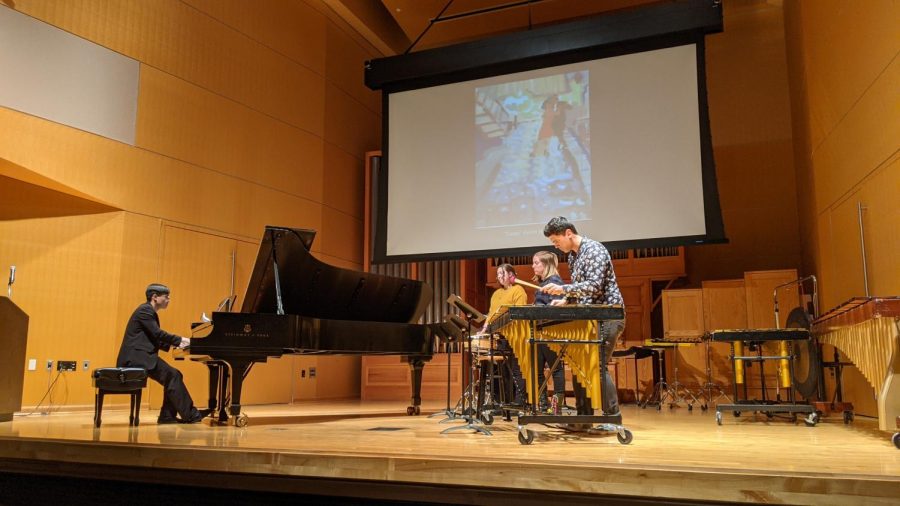Music & Autism event celebrates neurodivergent minds
Studios collaborate to create
May 4, 2022
Colorful music filled McIntyre Hall as a projection screen displayed various paintings by autistic artists on stage that served as inspiration for four original music compositions performed by the piano, percussion and composition studios on Sunday, April 24.
Dr. Yerin Kim was the artistic director and hosted the event, and after an entire year of planning, she said she was excited to see it all culminate on stage. Her background working with autistic students and inviting autistic people in various cities to view her rehearsals led to the creation of this event as an effort to combine two types of communities.
“I want for people to see things a little bit differently,” Kim said. “I know how much music is important for autistic minds. I’m playing and performing for autistic communities, and I wondered if there is a way to incorporate that on stage, if they can use their voice in our artwork. When we put it all together, it creates an incredible amount of synergy.”
According to Kim, the concert was live streamed and many of the painters were able to watch from around the nation. The paintings were sourced from “The Art of Autism” website, which features poetry, paintings, sculptures and mixed media art by autistic artists.
“They do a good job of really telling the stories of individual autistic artists there, so I have a lot of fun designing in my head what that year’s concert is going to look like,” Kim said.
The opportunity for collaboration between the percussion, piano and composition studios was an especially exciting element for many involved. Isaac Montgomery, senior in piano performance, played piano for a piece entitled “Third Movement” by painter J. A. Tan and composed by CWU student Nicholas Sasse.
“It’s just so unique working with the different professors as well as the different people,” Montgomery said. “Art can come from so many different places and [it’s fun] to go across studio boundaries sometimes and collaborate with different people who have different experiences, because that’s where true beauty in music happens.”
Junior in music education and composition Stephen Williford also said the collaborative aspect was one of her favorite parts of the concert. Williford composed the second piece entitled “Beautiful Colors,” by painter Jeremy Sicile-Kira and performed by CWU students Thomas Snedeker on marimba, Zack Mautz on vibraphone and Daniel Hankes on piano.
“One of the most exciting things about doing these composition events is getting to work with other young artists and getting to have that experience of sharing music,” Williford said.
Dr. Jiyoun Chung, professor of composition, composed the first piece of music based on a painting entitled “Randomosity” by painter Ikea Juanita “Syance” Wilson. The piece was performed by Mark Goodenberger on the marimba and Kim on the piano, and the sounds randomly meandered with hard-hitting moments of intensity interspersed throughout.
“There were many, many, many objects in the painting,” Chung said. “When you take a look at it closer, it has a little bit of quirkiness to it, humorous funny twists, also absolutely beautiful things, like a little reinterpretation of piano scales, piano keyboard, skies, sun, rainbow… When I first saw the painting, I felt like it was almost a film or something moving. It’s very dynamic.”
According to Kim, the composers had fun finding creative ways to use their instruments, including pianists who hit the strings with their hands and percussionists bowing their marimba with a string bow to get an intriguing sound. Given the current social climate, adding neurodiversity to the conversation seemed fitting to Kim.
“The efforts are incredible to become more diverse and inclusive,” Kim said. “It’s an exciting time, and it’s about time. There’s about three or four concerts a day at the music hall now, we’re used to performances and creating art, and for the audience to see that this type of partnership and collaboration is possible and it can create this much synergy and artistic excellence, I hope that that makes people realize that it’s not too difficult to do if you have an open mind.”
The composers expressed the significance of featuring voices that may not otherwise be in the spotlight.
“That was what was so special about this to me, was finding these underrepresented artists and really falling in love with that and finding personal connections in that work,” Williford said. “I hope the audience can feel that experience and learn from that experience.”
Similarly, Chung said that to the CWU music community, autism is not something that needs to be fixed or cured, it is simply a different way of living.
“For musicians and composers, we enjoy writing different music because we enjoy differences,” Chung said. “Difference is not something to feel uncomfortable about, it’s something we can celebrate together.”
Kim emphasized the importance of focusing on similarities in order to see beyond what sets us all apart.
“Neurotypical or not, we’re all very different anyways,” Kim said. “It’s good to find the commonness, the passion, the artistry, rather than focusing on what’s hard to understand.”




I disagree. • May 5, 2022 at 3:34 am
Quote
Similarly, Chung said that to the CWU music community, autism is not something that needs to be fixed or cured, it is simply a different way of living.
Unquote
I’m autistic and I personally disagree. It’s not something I like to admit or go through.